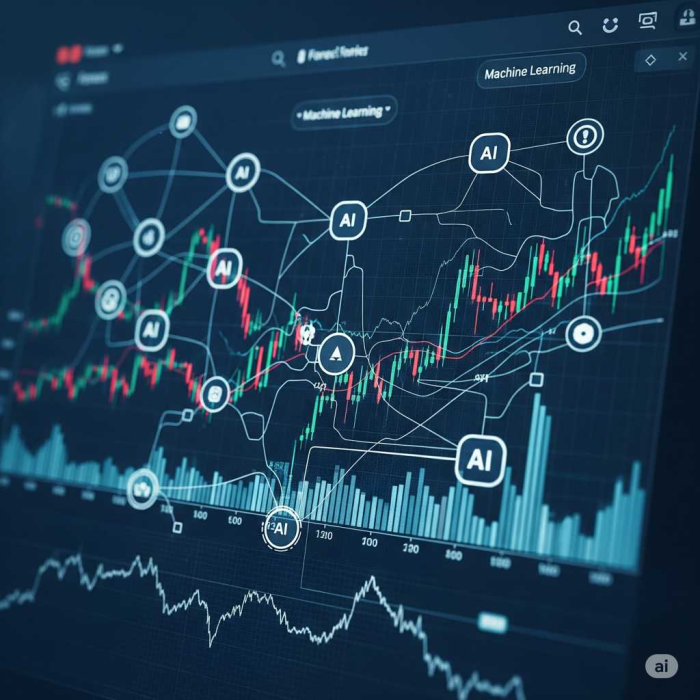The Algorithmic Edge| How AI and Machine Learning Are Reshaping Forex Trading
The foreign exchange (forex) market, a colossal and ever-shifting landscape, has traditionally been the domain of human intuition, experience, and quick-witted decision-making. However, a silent revolution is underway, powered by the relentless march of artificial intelligence (AI) and machine learning (ML). These technologies are no longer just buzzwords; they are actively reshaping how we analyze, predict, and execute trades in the world's largest financial market.

Why AI and ML in Forex? The Data Deluge
Forex trading is inherently data-rich. Every second, new price ticks, economic indicators, geopolitical events, and news headlines flood the market. For a human trader, processing this sheer volume of information and identifying actionable patterns is a Herculean task. This is precisely where AI and ML shine.
- Pattern Recognition Beyond Human Capacity: Traditional technical analysis relies on identifying recurring patterns in charts. AI, particularly neural networks, can identify far more complex and subtle patterns across vast datasets that would be imperceptible to the human eye.
- Speed and Efficiency: AI-powered systems can analyze data, generate signals, and even execute trades in milliseconds, offering a significant advantage in a market where speed is paramount.
- Eliminating Emotional Biases: Human emotions – fear, greed, panic – are notorious for derailing trading strategies. AI systems, by their very nature, are devoid of emotion, leading to more consistent and disciplined execution of pre-defined strategies.
- Adaptability and Learning: Machine learning models are designed to learn and adapt. As market conditions change, they can adjust their strategies, optimizing performance over time without constant manual reprogramming.
Key Applications of AI and ML in Forex Trading
- Predictive Analytics: This is perhaps the most exciting application. ML algorithms can be trained on historical price data, volume, economic indicators, and even sentiment analysis from news and social media to predict future price movements with a higher degree of accuracy than traditional methods.
- Algorithmic Trading Strategies: AI can develop and execute sophisticated trading strategies based on a myriad of factors. This includes high-frequency trading, arbitrage opportunities, and even more complex strategies that adapt to market volatility.
- Risk Management: AI can analyze vast amounts of data to identify potential risks, optimize position sizing, and implement stop-loss orders more effectively, helping traders minimize losses and protect capital.
- Sentiment Analysis: Natural Language Processing (NLP), a subfield of AI, can sift through news articles, social media feeds, and financial reports to gauge market sentiment towards specific currencies or economic events, providing valuable insights for trading decisions.
- Personalized Trading Assistants: Imagine an AI assistant that learns your trading style, identifies your strengths and weaknesses, and offers personalized recommendations and alerts. This is becoming a reality.
The Road Ahead: Challenges and Opportunities
While the potential is immense, it's important to acknowledge that AI and ML in forex trading are not a magic bullet.
- Data Quality and Bias: The accuracy of AI models heavily depends on the quality and representativeness of the data they are trained on. Biased or incomplete data can lead to flawed predictions.
- Market Volatility and Black Swans: While AI can adapt, extreme market events (black swans) can still pose significant challenges to even the most sophisticated models.
- Over-optimization (Curve Fitting): There's a risk of creating models that perform exceptionally well on historical data but fail in live trading due to over-optimization.
- Accessibility and Cost: Developing and deploying advanced AI/ML systems requires significant technical expertise and computational resources, which can be a barrier for individual traders.
However, as AI tools become more accessible and user-friendly, and as our understanding of these technologies deepens, we can expect to see even more sophisticated and integrated solutions emerge.
Conclusion: The Future is Algorithmic
The integration of AI and machine learning into forex trading is not a fleeting trend; it's a fundamental shift. While human intelligence and strategic thinking will always play a role, the algorithmic edge provided by AI and ML is becoming increasingly crucial for navigating the complexities and capturing opportunities in the forex market. For traders and investors looking to stay ahead, understanding and embracing these powerful technologies will be key to unlocking new levels of efficiency, accuracy, and profitability in the years to come.
Popular Tags